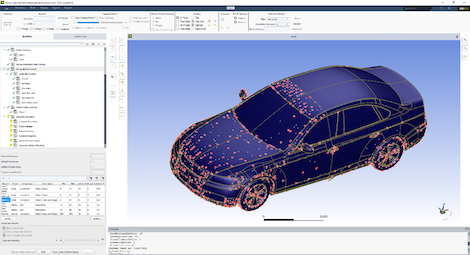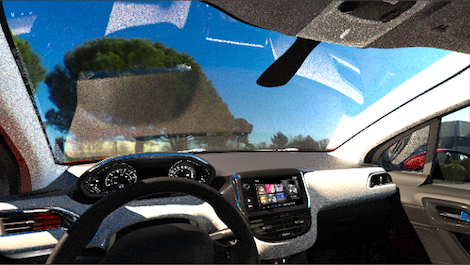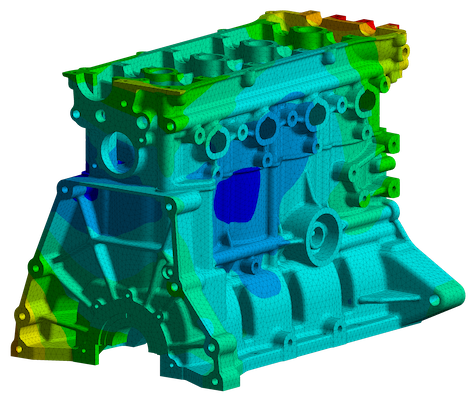
Natural Frequency study of an engine block done in Ansys 2019 R2
From ideation to design to manufacturing and operations, Ansys 2019 R2 is aiming to accelerate, streamline and simplify the product lifecycle with its new functionalities.
Ansys Mechanical features a new user experience that promises increased speed in adoption, while simplified simulation of complex electronics and a new Ansys Fluent workflow should significantly speed the meshing of dirty geometries.
R2 includes new materials capabilities for structural analysis following the recent acquisition of Granta, while Ansys boasts of new accelerated simulation solutions collaboration, validation and verification — creating a reliable digital thread between all operations.
“Design, engineering and manufacturing practices are changing at lightning speed — organisations are leaning on simulation and digitising their processes to bring cutting-edge products to customers faster than ever,” said Shane Emswiler, vice president and general manager for Ansys electronics, fluids and mechanical business units.
“This release empowers customers to do more with multiphysics simulation in less time. ANSYS 2019 R2 automates simulation while making it easier to use.”
Highlights of the Ansys 2019 R2 release include:
New user experience and more in Ansys Mechanical
R2 and the acquisition of DfR Solutions, means Ansys Mechanical is looking to cement an industry lead for usability and productivity and the introduction of a new user interface in Mechanical is what it hopes will speed up user adoption.
By adding DfR Solutions’ Sherlock to the portfolio, it now offers a turnkey, end-to-end solution in what Ansys calls ‘electronics reliability’.
“The recent acquisition of DfR Solutions provides users an easy-to-use solution focused on mechanical reliability for electronic products,” said Jim Hunter, manager at Viasat Reliability Engineering and Ansys customer. “Electronic product CAD assemblies which previously took weeks to create can now be assembled and solved in under an hour.”
Beyond this R2 includes enhanced SMART fracture modelling, a new topology optimisation methodology offers to reduce the time to prepare the resultant geometry – shortening the digital thread.
Also included in Ansys 2019 R2 is an automatic meshed-based connection for shell and beam models, which is a key offering for oil and gas structures and heavy industrial equipment models.
New materials offerings
Following the acquisition of Granta, Ansys 2019 R2 embeds data on more than 600 materials within Ansys Mechanical as it looks to speed up the process of setting up models by reducing time spent looking for material properties.
The Ansys Granta Materials Data for Simulation data package is a bit of a mouthful, but it provides a broad coverage of material types and easy access to key data needed for structural analysis.
New tools for simulating complex electronics
New offerings in the electronics and electromagnetics suite include important new features for engineers meeting complex design challenges. Accelerated doppler processing in Ansys HFSS SBR+ expedites the modelling of ADAS radar scenarios related to autonomous vehicles and other near-field radar sensing systems by 100X.
R2 also introduces TAU Flex meshing, a powerful new meshing technology enabling users to efficiently obtain design trend information earlier in the design cycle.
Additionally, in collaboration with partner Modelithics, Inc., Ansys 2019 R2 introduces a new library of HFSS 3D component models for the design of 5G and wireless communication systems.
Ansys Cloud added to Electronics Suite
The Ansys cloud-based high-performance computing for structures, fluids and electronics product suites is given direct on-demand cloud access from the Ansys Electronics Desktop in 2019 R2, enabling Ansys HFSS and SIwave customers to seamlessly move into faster, distributed simulation.

Fluent task-based, fault tolerant workflow speeds meshing for dirty geometries
New Fluids Workflow Speeds Meshing of Dirty Geometries
In the fluids suite, ANSYS has enhanced and extended its new Fluent experience that accelerates digital transformation by enabling users to reportedly do more computational fluid dynamics (CFD), in less time, with less training than ever before.
Ansys reports that its new task-based, fault tolerant workflow meshes dirty, non-watertight geometries twice as fast without scripts or popups, with complex models ‘that previously took days or even weeks can now be meshed in hours’.
R2 users can further speed combustion simulations without sacrificing accuracy through the newly released capabilities – with parallel performance gains reportedly cutting simulation time in half for full-cycle internal combustion engine simulations that include spray, chemistry and flame propagation physics.
New hybrid meshing capabilities are also capable of reducing hands-on time by enabling users to completely mesh complex turbine blade models.
New SPEOS with Live Preview
The new Ansys SPEOS packages an integration that offers an ‘intuitive and comprehensive’ user interface — what Ansys suggests will increase productivity by computing GPU-based simulation previews within the Ansys multiphysics ecosystem.
The new Ansys SPEOS enables a faster and more iterative design potential and is accessible to engineers without CAD experience.
With the new SPEOS Live Preview, users can explore an interactive version of their SPEOS simulation model and obtain immediate rendering results directly on Ansys VRXPERIENCE.

Ansys VRXPERIENCE – SPEOS Progressive rendering
Revolutionary sound and driving offerings for VR
The new Ansys VRXPERIENCE Sound ramps up the ability to improve VR experiences for brand image and the sound quality by listening and modifying the sound coming from a recording or CAE.
Billing itself as ‘the premier software and comprehensive solution for sound analysis, sound quality measurement and 3D playback’, the tools are now connected to Ansys Mechanical.
Driving Simulator Powered by SCANeR, lets users virtually test scenarios in direct connection with Ansys VRXPERIENCE, with the capability to prepare advanced scenarios and run simulations including events, surrounding traffic and vehicle dynamic with complete and accurate multi-body vehicle dynamics.
New features for System Simulation and Digital Twins
Ansys Twin Builder 2019 R2 enhances Modelica workflow capabilities, making it easier for users to quickly implement and edit Modelica components in their systems designs.
Support for undo-redo and a new array connector dialog box are a few of these new capabilities, while new solver performance enhancements in the product improve performance reportedly by up to 30 per cent.
Multiphysics Performance Improvements
In the multiphysics suite, all multiphysics simulation cases that use System Coupling benefit from ‘performance improvements of 3X for the coupling engine’ — stats that should increase overall run times by 20 per cent or more.
With the update, users can run mixed steady-transient analyses, which increases simulation efficiency when modelling a multiphysics application with fast physical effects on one side and a slower response on the other. The “fast” physics can be run as steady-state and the slower response as transient.
More comprehensive and insightful 3D Design Exploration
Ansys Discovery continues its forward momentum with live thermal stress and electrical conduction simulation.
Faster and easier Additive Manufacturing
Ansys Additive Prep, built right into Ansys SpaceClaim, makes orienting parts and creating advanced support structures easier.
New heat maps give fast feedback on optimal supports, distortion tendency and build time while native support generation tools are fast and easy to use.






